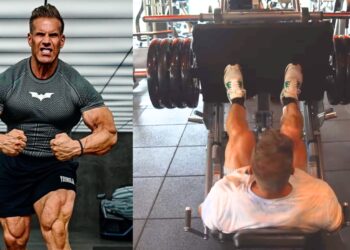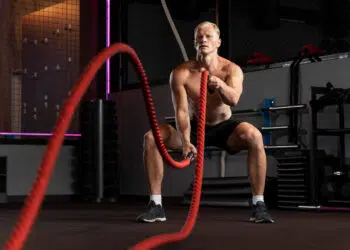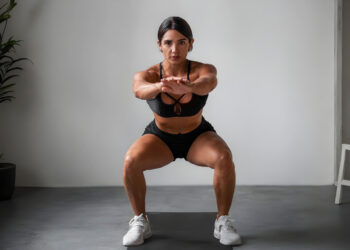I believe the squat jack is an excellent bodyweight cardio exercise that is particularly effective in high-intensity interval training (HIIT) sessions.
One of the studies I read recently concluded that HIIT exercises are more effective at improving overall cardiovascular and respiratory health than moderate-intensity continuous training (MICT). [1]
This is why I decided to create an easy-to-follow step-by-step guide so you can learn how to perform squat jacks with proper form and technique and maximize your muscle endurance and cardiorespiratory fitness.
Towards the end of the article, in the FAQ section, I will also give you an example of how to implement squat jacks into HIIT workouts to maximize their benefits.
Let’s start with an exercise guide first.
What is a Squat Jack?
Most lifters use additional resistance on a strength training exercise, like a squat. However, squats can emulate cardiovascular benefits depending on how you execute the exercise, thus, overlapping the two exercise techniques.
Level Up Your Fitness: Join our 💪 strong community in Fitness Volt Newsletter. Get daily inspiration, expert-backed workouts, nutrition tips, the latest in strength sports, and the support you need to reach your goals. Subscribe for free!
The squat jack is a more challenging variation to the jumping jack, where you land in a squatted position instead of jumping your legs wider than shoulder-width apart.
Squat jacks are a compound (multi-joint) lower-body power movement that targets the gluteus, hamstrings, and quads. This means that it’s a great exercise to help strengthen your lower body, and since it’s an explosive movement, it will drive your heart rate up, giving you that calorie-burning edge. While regular jumping jacks don’t tend to build muscle, squat jacks can help grow your quads and glutes.
How to Perform a Squat Jack
Let’s look at the proper way to perform the squat jack. You can use a mini band for added resistance. Before you execute the squat jack, ensure that you have your squatting mechanics down. Warm up with 10-20 bodyweight squats before starting.
Variation 1
You could perform a full-body or lower-body-specific squat jack. This variation helps you train your entire body.
Step One — Assume a Half-Squat Position

Assume a half-squat position with your feet around shoulder-width apart, and toes pointed slightly outward. Your knees should align with your toes, meaning you should avoid caving them inwards.
Keep your chest up and back flat. Hold your arms in front of your chest while maintaining a neutral head, neck, and spine position, avoiding any sagittal, frontal, or transverse movement.
Pro Tip: Keep your core engaged throughout the half-squat to maintain balance and protect your lower back. This will also help in generating more power for the explosive jump.
Step Two — Explode to the Top Jumping Jack Position
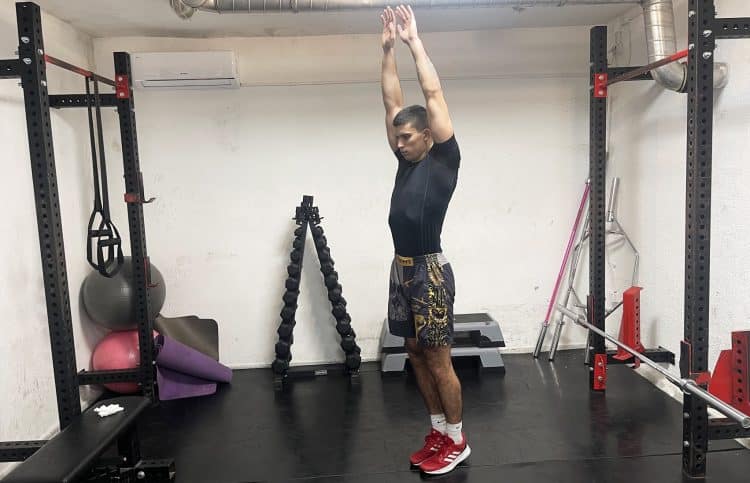
Explode off the floor and bring your feet together while extending both arms over your head. All your joints should be fully extended at the top of the jump. Land on the floor with both feet together and arms overhead.
Pro Tip: As you jump upward, focus on a strong but controlled arm swing to maximize your vertical lift and ensure a full range of motion. It can enhance the exercise’s cardio intensity.
Step Three — Descend Into the Half-Squat Position
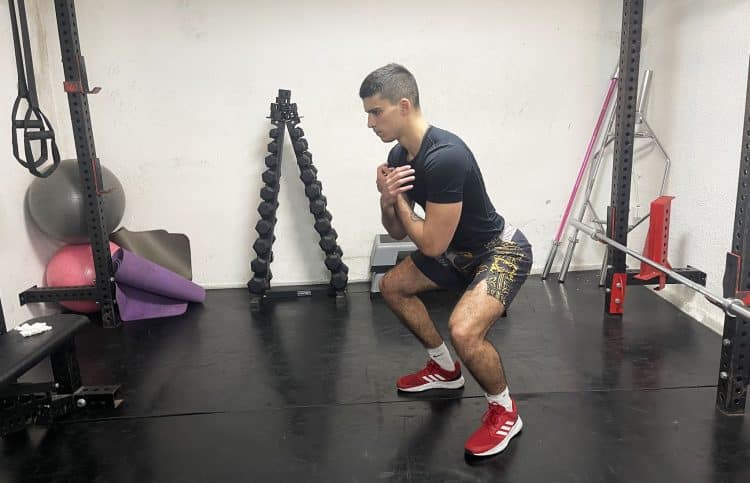
Reverse the motion by jumping back to the half-squat position with your feet around shoulder-width apart and toes pointed slightly outward.
Pro Tip: Land softly on the balls of your feet before rolling back to your heels, like a spring, to reduce the impact on your joints and prepare your muscles for the next repetition.
Watch Vanja Vukas demonstrate the squat jacks exercise:
Variation 2
If you want to focus on just the lower body, follow these steps:
Steps
- Begin in an athletic position, slightly flexed at the hips and knees.
- Set your feet hip-width apart, shoulders back, chest up, and hands clasped before your chest.
- Descend into a squat. Keep your torso upright, and your hips remain seated back. Knees track over the toes.
- Stay on the balls of your feet, and jump your feet out approximately shoulder width apart.
- Quickly jump your feet back so that they remain stacked under your hips.
- Jump your feet back out shoulder-width apart.
- Repeat for reps.
In This Exercise:
- Target muscles group: Quads, Glutes, and Hip flexors
- Secondary muscles: Hamstrings, Calves, and Abs
- Type: Strength
- Mechanics: Plyometric
- Equipment: Bodyweight or Resistance Band
- Difficulty: Intermediate and advanced
- Reps: 15-20 reps
- Sets: 3-4
Muscles Worked in a Squat Jack
All these muscles work together to complete a squat jack:
Glutes
The glutes are the primary movers in the squat jack. During the squat jack, the glutes achieve maximal stimulation at the movement’s top. The gluteus maximus is the main part of the glute muscles activated during a squat. [2]
Quads
The quads are the second main mover in the squat jack. When performing the squat jack, the quads become most activated during the eccentric portion of the movement. [3]
Four heads of the quadricep assist in knee extension, and one head functions in hip flexion.
- Vastus Lateralis
- Vastus Medialis
- Vastus Intermedius
- Rectus Femoris: Knee extension and hip flexion
Hip flexors
These are the groups of muscles that join your legs to your trunk. Hip flexors enable you to raise your leg or knee upward and bend your torso forward. There are two ways to flex your hip:
- Adduction: The movement of a limb toward your body
- Abduction: The movement of a limb away from your body
When performing the squat jack, your legs will primarily move in abduction.
Hamstrings
The hamstrings work as a stabilizer muscle during the squat jack. They tend to activate at the top of the movement, assisting the hips. To understand this further, let’s look at the hamstring’s function. The hamstring crosses at the knee and hip joint. It controls knee flexion and hip extension. The three parts of the hamstring are [4]:
- Semitendinosus
- Semaimembranosous
- Biceps Femoris
The hamstring is prone to injury, so stretch before performing an explosive exercise.
Core
To land in a squatted position, you must stabilize your torso. The core or abdominal muscle that supports the squat jack movement is the rectus abdominis. The rectus abdominis is the top layer of your abdomen (the six-pack). It is two flat and parallel muscles separated by connective tissue. [5]
Benefits of the Squat Jack
There are several benefits of adding a plyometric squat to your program, including:
Level Up Your Fitness: Join our 💪 strong community in Fitness Volt Newsletter. Get daily inspiration, expert-backed workouts, nutrition tips, the latest in strength sports, and the support you need to reach your goals. Subscribe for free!
Increase Speed
Squat jacks fire your fast-twitch muscle fibers. Fast-twitch muscle fibers contribute to a quick burst of energy. For athletes, they generate power for sprinting and quick directional movements. The general population needs fast-twitch muscle fibers for activities like weightlifting or high-intensity exercises.
Increase Cardiovascular Endurance
Jumping exercises increase your heart rate and respiration, challenging the cardiovascular system. Performing high reps of the squat jack will improve your aerobic capacity and endurance. Squat jacks challenge your respiratory system and make you breathe hard. Aim to move as fast as you can with the movement using the correct form. You only need 20-30 seconds of squat jacks to elevate your heart rate.
Increased Lower Body Strength
Jumping jacks can help build foundational lower body strength in beginners. Jumping engages your fast-twitch muscle fibers, which are called into action during max-effort lifts, plyometrics, and similar high-intensity movements. [6]
Build Lower Body Strength
Squat jacks help build lower body strength. The higher and faster you jump, the more power you generate. You can add a resistance band to work your hip flexors harder. Building leg strength with the squat jack will improve your squats, deadlifts, vertical jumps, running speed, and everyday activities like walking up the stairs.
Strengthen Stability, Posture, and Balance
To jump and land in an upright, stable position requires core strength. Squat jacks look simple but require some coordination, challenging your balance.
Improve Mobility
Squat jacks are a form of lateral training. Because the movement of the legs is from side to side, this helps strengthen the smaller muscle around the hip joint that running and walking don’t address. This lateral movement can prevent injury.
Common Mistakes in the Squat Jack
Here are the common mistakes to avoid when performing the squat jack:
No Warm-Up
This exercise is not a warm-up. Perform an active dynamic warm-up, run, or jump rope to get the blood flowing. You can then perform the squat jack at the beginning of your workout.
Incorrect Surface
When performing plyometric exercises, you want to be on a surface that supports soft impact and protects your joints from injury. You shouldn’t use an extremely soft surface because it can interfere with the release of stored energy in your jump. This diminishes the force and power in your jump. You shouldn’t perform on extremely hard surfaces, either, like concrete. Instead, find a stable and even surface like grass (real or turf) or rubber flooring.
Adding Weight
You don’t need to add weight like a vest or ankle weights to this exercise; it won’t increase muscular gains. The best way to increase stronger muscular contraction with your fast twitch muscles is to perform squat jacks after you do a barbell squat. The advantage of this is called post-tetanic potentiation [7]. PTP refers to gaining a more muscular response from a second exercise by preceding it with a strong muscular contraction.
Variations and Alternatives to Squat Jack
The following exercises will elevate your heart rate and target the same muscles as the squat jack. From beginner to elite athletes, there is something here for everyone. All exercises can be done using your body weight or resistance band.
Sumo Step Jack
This is a low-impact variation for beginners or those recovering from injury. You can use your body weight or a medicine ball (4-8 pounds) to add resistance.
Steps:
- Start with your feet wider than shoulder-width apart.
- If using a medicine ball, hold it at chest level. Alternatively, you can place your hands behind your head or clasp them at your chest.
- Lower into a squat.
- As you stand up, pick one foot off the ground, driving your knee toward your chest.
- Place your foot back on the ground, and return to the sumo position.
- Repeat on the other side.
Pro Tip: You are trying to push directly from the ground with just one leg. This will challenge your balance.
Seal Jack
This is a great place to get started for a beginner. Before adding the squat component, the seal jack works your upper body while using the same mechanics of the lower body in the squat jack.
Steps:
- To start, stand with your feet together and your arms together out in front of you at shoulder height. Place your palms together.
- Simultaneously, jump your feet and hands out wide (wider than shoulder width). Feel your back working as you pull your arms out.
- Quickly jump your feet and arms back to the center, palms touching, arms remaining at shoulder height.
Pro Tip: If you still struggle with jumping, regress the movement to a step variation.
Star Jump
While the squat jack focuses on quick, short movements, star jumps add more power and explosiveness to your workout. This movement is for advanced trainers.
Steps
- Start in an athletic position (hips back, knees slightly bent, shoulders square, chest up, and arms by your side).
- As you jump, raise your legs to the sides and swing your arms out to the sides and up overhead.
- To land, bring your feet back together and sink back into your athletic position.
- You can squat a little as you land to help load your legs for the next jump while also landing softly to protect your knees.
- Bring your arms back down to your sides as you land, and then repeat.
Pro Tip: You can build explosiveness by starting this movement with smaller jumps. The higher you jump and the quicker you perform the reps, the harder the exercise will be. Pause between reps to make the exercise easier.
Split Squat Jack
Switching the movements from bilateral to unilateral is a great option for advanced lifters. Generating power from one leg can provide many benefits, such as explosive coordination, reactivity, and improved athletic performance.
Steps:
- Start by stepping one foot back and sinking into a lunge with your arms at your side.
- Swing your arms up and overhead, jumping off the ground simultaneously.
- In the air, switch legs and land in a lunge on the opposite side.
- Repeat to land back on the starting side.
Pro Tip: To get the most out of this exercise, quickly land and jump right back up. To make this more advanced for athletes, switch your legs in the air twice, landing on the same side you started with instead of the opposite side.
FAQs
Are squat jacks and squat jumps the same?
Although they work the same major muscle groups, squat jacks and squat jumps train your muscles differently.
Squat jacks provide high anaerobic (without oxygen) benefits. They help improve lateral speed and increase fast twitch muscle fibers for speed and agility.
Squat jumps build muscular power and explosiveness. Explosive power allows you to take off faster and move quicker, which athletes need. Even if you’re not on the field, power is still needed for real-world activities like lifting heavy objects or standing and sitting multiple times a day. Plus, the flexibility gained in your ankles and hips from the jump squat will help prevent injuries during other exercise routines.
How often should I program for plyometrics?
Plyometrics are great when training. They contribute so many benefits to people at any training experience level. Plyo training is recommended 1-2 times a week in conjunction with a strength-based exercise [8].
If working on individual plyometric exercises, perform the movement anywhere from 15-30 seconds with a 1-2 minute rest, depending on your fitness level. You only need to perform 2-5 reps of 3-4 sets.
What is my target heart rate during a squat jack?
The squat jack is a high-intensity exercise. Therefore, it’s important to know where your heart rate should be when performing the exercise. To measure your maximum target heart rate, deduct your age from 220. To calculate your target heart rate, multiply your maximum heart rate by the intensity of your workout. For example, if your MHR is 191 (220-29=191) and you are performing the squat jack at 70% intensity, your target heart rate should be 133 (THR = 191 x .70).
Wrapping Up
The squat jack is a great exercise to amp up your cardio-based strength training. It helps develop speed, mobility, and stability; focuses on lower body strength and athleticism, and comes with many variations, alternatives, and progressions for all skill levels. The star jump, in particular, is a great way to combine the best elements of the squat jack and squat jump to generate speed, power, and strength.
Reference
- Karlsen T, Aamot I-L, Haykowsky M, Rognmo Ø. High-Intensity Interval Training for Maximizing Health Outcomes. Prog Cardiovasc Dis. 2017;60(1):67-77. doi:10.1016/j.pcad.2017.03.006
- Gluteus muscle | anatomy. Encyclopedia Britannica. https://www.britannica.com/science/gluteus-muscle
- The Editors of Encyclopedia Britannica. Quadriceps femoris muscle | anatomy. In: Encyclopædia Britannica. ; 2018. https://www.britannica.com/science/quadriceps-femoris-muscle
- hamstring | Description, Function, & Injury | Britannica. www.britannica.com. https://www.britannica.com/topic/hamstring
- Rectus Abdominis. Physiopedia. https://www.physio-pedia.com/Rectus_Abdominis
- Plotkin DL, Roberts MD, Haun CT, Schoenfeld BJ. Muscle Fiber Type Transitions with Exercise Training: Shifting Perspectives. Sports (Basel). 2021;9(9):127. Published 2021 Sep 10. doi:10.3390/sports9090127
- Poliquin Group. Five Ways to get the most out of plyometrics. Poliquin Group. Published 2014. https://www.poliquingroup.com/ArticlesMultimedia/Articles/Article/1245/Five_Ways_to_Get_the_Most_out_of_Plyometrics.aspx
- Balance N. What is Plyometric Training. Nordic Balance. Published April 9, 2020. Accessed March 8, 2023. https://nordicbalance.co.uk/training/what-is-plyometric-training-how-to-incorporate-it-into-your-training/
Relevant Articles:
Interested in measuring your progress? Check out our strength standards for Bodyweight Squat, Deadlift, Hip Extension, and more.



